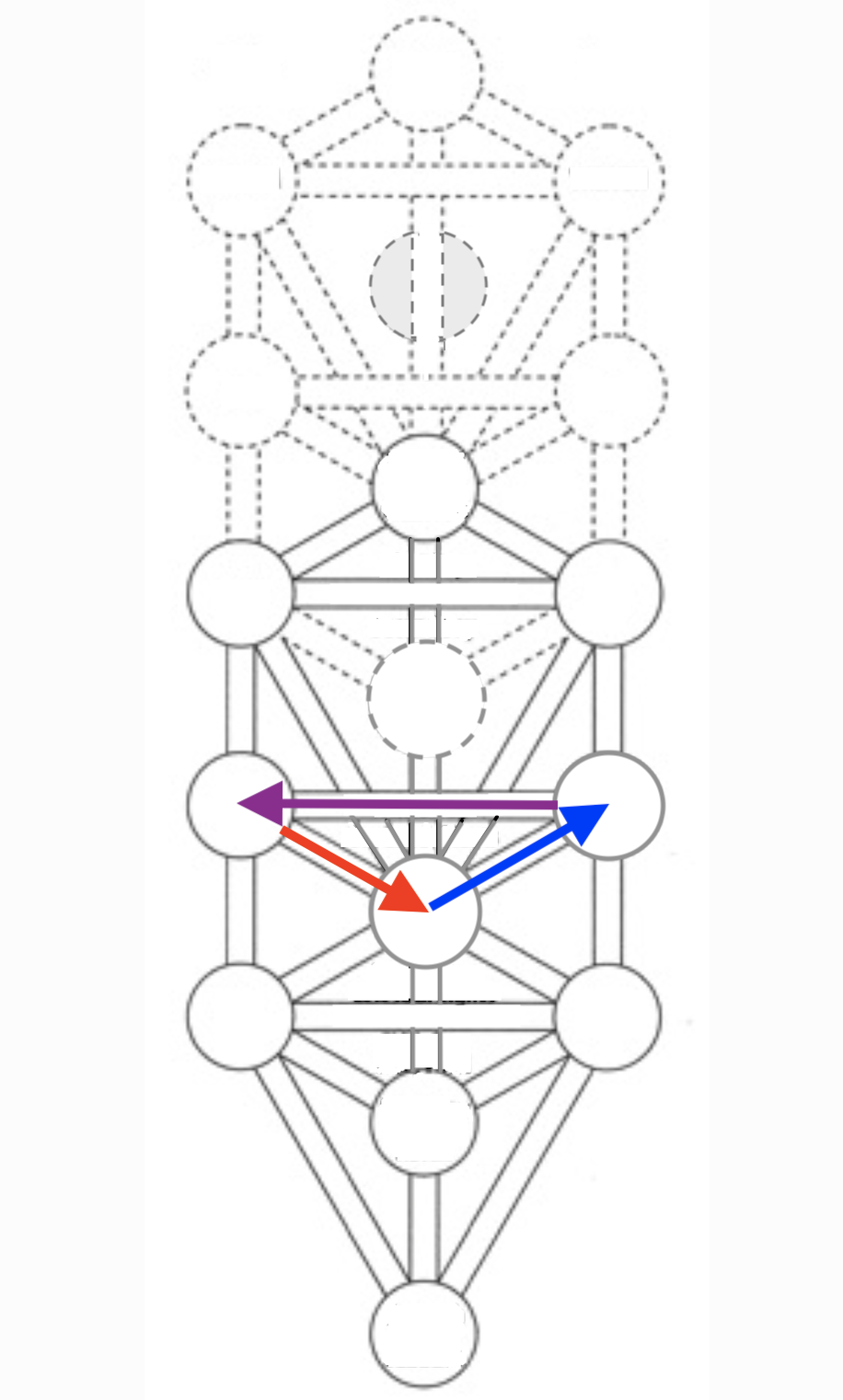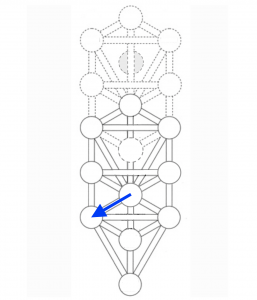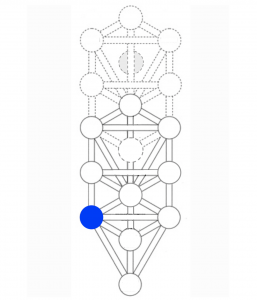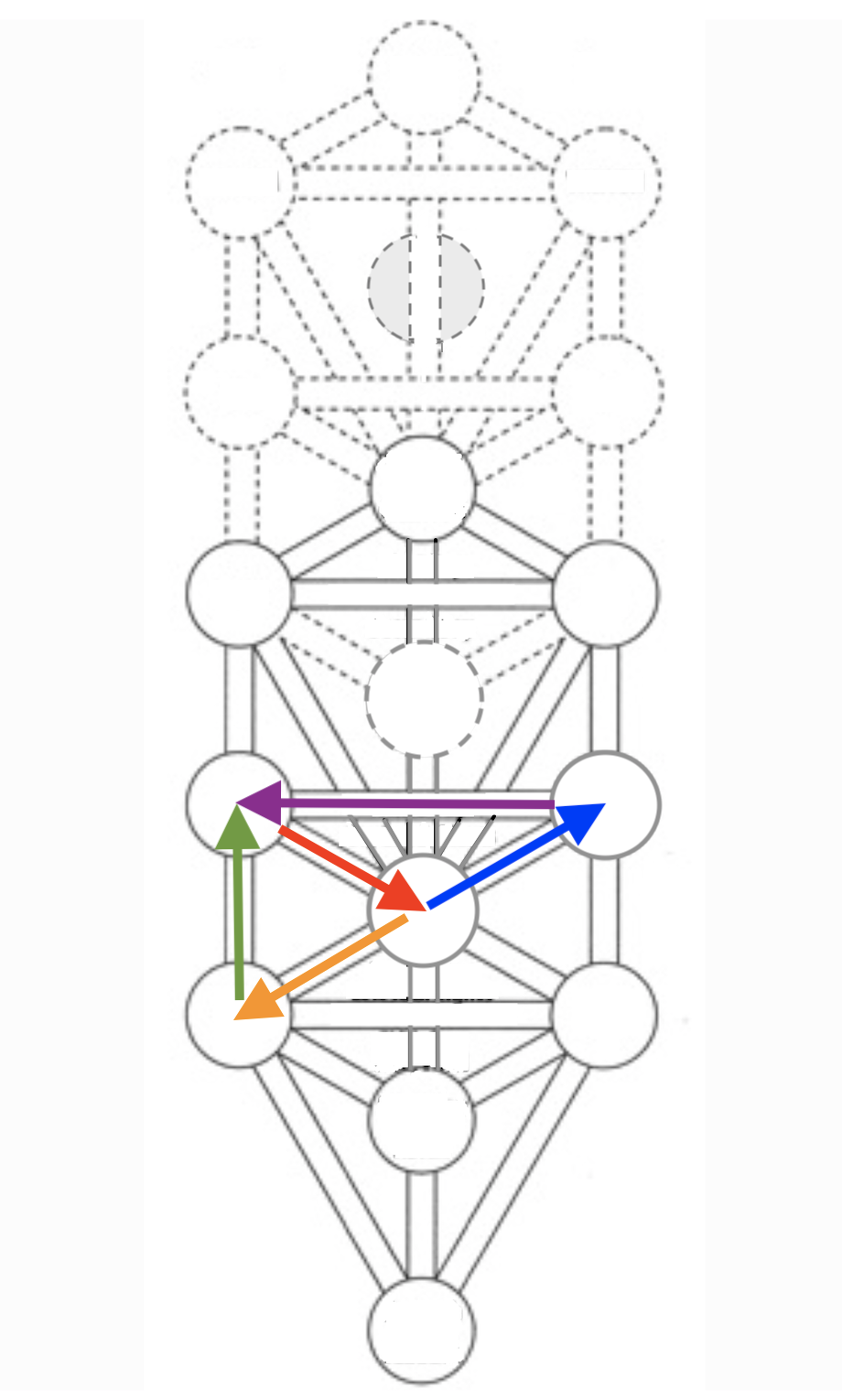The Kabbalah, the Tarot and the Middle Way
Kenneth Chan
8. Stabilizing the Limitless Light

The three paths that form the primary circuit in Assiyah—from Tiphareth to Chesed to Geburah and back to Tiphareth—serve to refine the state of realization in Tiphareth. The circuit has to be traversed many times, and each time the circuit is completed, we reach a higher level of realization.
There is one other thing that needs to be done with the higher and higher realizations we attain in this process, and this is required to progress on our spiritual quest. We need to transform our personality and behavior in accordance with these realizations. Otherwise, all we have is a vision of a higher spiritual state but we are not living it, and at some point, we will be unable to progress further. This means that we have to take the path from Tiphareth to Hod.
The paths from Tiphareth to Hod, on all the Trees of Life, have the property of a transformation of our core reference perspective in line with the new realization at Tiphareth. It is a transformation of our basic personality to one that endeavours to live out the higher spiritual state. This path, on the Tree at Assiyah, is described by the Yetziratic text as follows:

The 26th Path: Tiphareth – Hod
“The Twenty-sixth Path is called the Renewing Intelligence because it is the means through which the Blessed Holy One renews all the changing things which are brought into being in His creation.”
Hebrew letter: Ayin. Eye.
Noble Eightfold Path: Right Effort
It is the Renewing Intelligence because it is a path of transformation, the creation of a new perspective and a different world of experience. This is the path that brings the new spiritual realization at Tiphareth to the realm of practical manifestation at Hod.
The Noble Eigthfold Path depicts this path as Right Effort. In Buddhist terms, this process would be akin to the effort to bring our post-meditation state of mind closer to the spiritual realization reached during meditation. This generally requires considerable effort and persistence because, when we are out of our meditative state or our state of mystical experience, we are confronted with a deluge of distractions in our mundane world as well as having to think about and perform our daily tasks in order to maintain our livelihood.
While the processes of meditation, contemplation, and thought transformation, are crucial in bringing about a new realization, it is the incorporation of the spiritual values into our practical life that really counts. The process of gaining a new realization is like the pioneering spirit, the cutting edge, the intrepid scout who forges ahead in order to light a beacon to guide the rest. In the end, the aim is to bring everything to that point of attainment, a transformation of our whole being to fill that vision. Thus the aim is to transform our life. In this way, the attainment of a spiritual realization is not an end, it is the beginning. It is like a signpost telling us where to go. The real work is then to go.
Apart from changing our perspective of the world, the words “it is the means through which the Blessed Holy One renews all the changing things which are brought into being in His creation” would suggest that the mind also has control over how material entities manifest. At least, to some extent, the scientific evidence from quantum physics do suggest that, even for our own minds, this may well be true. (See A Direct Experiential Interpretation of Quantum Mechanics.) In other words, the observer does play a role in how our “external” world manifests. In similar words to that used by Werner Heisenberg, one of the pioneers of quantum mechanics, we may say that the transition from the ‘possible’ to the ‘actual’ takes place during the act of observation. Thus, in like manner, it may well be said, in accordance with the words from the Sefer Yetzirah, that it is the collective sentience of the All, consistent with the ‘One’ as envisaged by Plotinus, that brings about the manifestation of the world. In the process, all the changing things (as opposed to the immutable universal laws) are renewed.
The path from Tiphareth to Hod is depicted by the Hebrew letter that means “eye,” since it is the eye that finally sees clearly enough to transform our reference perspective, so that all our actions are now guided by it. This is no easy task and we will require dogged determination to cut our way through the thick undergrowth and dense fog of our deluded habits. For we are out to do no less than to create a new world, to build a new life.
We are out to transform Hod, which is described by the Yetziratic text as follows:

HOD – GLORY
“The Eighth Path is called the Absolute or Perfect Intelligence because it is the mean of the Primordial, which has no root by which it can cleave or rest, save in the hidden places of Gedulah, from which emanates its proper essence.”
Spiritual Experience: Vision of Splendour.
As discussed earlier, Hod is the “mean of the Primordial” because it is our core reference perspective, our internal view which guides our motives and actions. In its ideal state, it is the Absolute or Perfect Intelligence, after the refinement from all the paths leading to it, from Malkuth, Yesod, and Tiphareth. It is also the “mean of the Primordial” because it is the focus which holds things together in the Tree of Asiyyah, and it keeps this role until the door to the higher Tree, Yetzirah, is opened, when the role will then be taken over by Binah (which then becomes Hod in the Tree of Yetzirah).
We have already discussed the rest of the Yetziratic passage and how it delineates the direction of the paths involving Hod.
The last part of the description states that the proper essence of Hod emanates from the hidden places of Gedulah (which is another name for Chesed). This is, in fact, a perfect description of what happens on the spiritual journey: The realization of the next step we have to take, to become a better person, arises from Chesed, our Buddha nature, or our Master Within, and through the power of our will at Geburah, we accept this step and maintain, through mindfulness, this realization and transform our mindset, thus refining Tiphareth. Then through the path from Tiphareth to Hod, we apply the effort to transform our very personality and behavior in life to align with this new state of realization.
This brings us to the path from Hod to Geburah. All the paths from Hod to Geburah are of the nature of an influence on our reference perspective that stimulates the will. This path, on the Tree in Assiyah, is described by the Yetziratic text as follows:

The 23rd Path: Hod – Geburah
“The Twenty-third Path is the Stable Intelligence, and is so called because it has the virtue of consistency among all numerations.”
Hebrew Letter: Mem. Water.
It is the Stable Intelligence (or Sustaining Intelligence) because, here, the virtues, previously experienced in Yesod and Tiphareth, have been incorporated into Hod, our personality and our post-meditational state. These values have now become part of our normal functional personality and perspective, the base from which we operate from, and thus have become stable.
This path is also the Stable or Sustaining Intelligence for another reason. When we bring the realizations and mystical experiences of Yesod and Tiphareth into the real world, we will realize how unsatisfactory the experiences of the mundane world really are. It is thus the Stable Intelligence because we will now come to the realization of the most consistent thing in our unenlightened existence (Samsara)—that it is in the nature of suffering. This is known as the First Noble Truth in Buddhism.
There are three types of suffering: the suffering of suffering, the suffering of impermanence, and the intrinsic suffering of conditioned existence. The first type, the suffering of suffering, is easy to recognize. It is the suffering of pain, sickness, sorrow, frustration, fear, … things which no one will dispute is suffering. The second, the suffering of impermanence, is also easy to understand. It is simply the fact that the things we cherish in this life will perish, sooner or later; it is all fleeting, like the wind. Whatever we cling to will give us only pain in the end, for inevitably we will lose it.
The third type of suffering—the intrinsic suffering of conditioned existence—however, is one most people do not readily recognize. But it is a condition openly evident to a higher being or one who has experienced the bliss of mystical states. The intrinsic suffering of conditioned existence is thus our usual state of separation from the bliss of enlightenment. It is like an open wound with the ever-present potential for severe pain. And our mundane happiness is, in fact, only the absence of greater suffering, or a temporary distraction from the more severe pains of life. It is not real happiness even while it lasts, and it does not last long.
To realize that Samsara is in the nature of suffering is to realize the First Noble Truth of Buddhism, and it is an important component of the path from Hod to Geburah, the Stable Intelligence. But it is not something we can completely realize in an instant; it is achieved in stages. Therefore, this is a path we have to traverse many times.
For example, while impermanence may be easy to understand intellectually, it is difficult to realize in sufficient depth so that we actually live our lives in accordance with this transitory nature. In the Indian epic, the Mahabharata, one of the heroes, Yudhistira, was posed with the question: “What is the greatest wonder?” Yudhistira’s reply was: “Day after day and hour after hour, people die and corpses are carried along, yet the onlookers never realize that they are also to die one day, but think they will live forever. This is the greatest wonder of the world.”
Truly, there is nothing more certain in life than the fact that we all die. Yet few of us realize this deeply enough for it to serve as a guide to our path. Instead, we often behave like sheep, waiting to be slaughtered, spending all their time fighting over the best patch of grass to graze on. The realization that we will die actually generates tremendous energy for the spiritual quest. That is why meditation on death is one of the crucial practices in Tibetan Buddhism. Even with an interest in the spiritual path, we are like a plane ever cruising around the airport grounds, unable to take off. When we know we will die, and know it deeply, we will have the necessary fuel to send us soaring to the skies.
This path, from Hod to Geburah, may be characterized as a path of learning from life itself. And because we have incorporated the experiences and realizations from Yesod and from Tiphareth into Hod, we are far more able to realize that Samsara is in the nature of suffering, the realization of the First Noble Truth of Buddhism. We realize that even the pleasant experiences of our mundane existence all pale in comparison to the spiritual experiences in a higher state of being. This realization of the suffering nature of our mundane existence is thus an important component of the path from Hod to Geburah, the Stable Intelligence, and helps motivate our will, at Geburah, to remedy the unsatisfactory situation.
There is another way this path stimulates our will at Geburah. The experiences at Yesod and Tiphareth all have the quality of generating a sense of unity and nonseparation, a sense of a binding cohesiveness of the All, where all sentient beings are not truly separate. After these realizations have been incorporated into Hod, our core reference personality, this sense of unity, coupled with the realization that our mundane existence is of the nature of suffering, nurtures the sense of compassion and helps to generate our desire to save all sentient beings from suffering.
The Hebrew letter for this path, Mem, means water, symbolizing consistency and the medium that we are to immerse ourselves in. It is the medium best suited for a fish, which thrives in it, and “fish” is the Hebrew letter assigned to the path from Netzach to Tiphareth, the path of compassion. There is no better motivation for the spiritual path than a mind of compassion immersed in a medium of suffering. Our motivation then becomes emotionally compelling, and the path becomes a necessity, for there is no other way to save our fellow sufferers.
In this way, Hod activates Geburah, which is described in the Yetziratic text as follows:

GEBURAH – SEVERITY
“The Fifth Path is called the Radical Intelligence because it resembles Unity, uniting itself to Binah, Understanding which emanates from the primordial depths of Chokmah, Wisdom.”
Spiritual Experience: Vision of Power.
Geburah is the Radical Intelligence because it represents the will that brings about radical change. It is the will to transform our mind, to bring it closer to the spiritual ideal, and this plays a critical role in generating the power for us to forge higher and higher in our spiritual quest. It resembles or has the essence of Unity because it is the driving force in instilling in us a sense of nonseparation and a oneness with the All.
The words “uniting itself to Binah, Understanding which emanates from the primordial depths of Chokmah, Wisdom” inform us of the paths to Binah that come from Geburah and Chokmah, and that both these paths serve to intensify the sense of unity with others.
When Geburah has been inspired by the path from Hod and from Chesed, it acts in two ways. One way is by generating the path to Tiphareth, so that this further refines the spiritual qualities of Tiphareth. The other way that Geburah acts, is represented by the path from Geburah to Binah (which we shall explore in the next chapter), and this is a crucial component of the drive towards opening the door to the next higher world of manifestation, the higher Tree of Life in Yetzirah.

In summary, there are actually two circuits in Assiyah that are mediated by Tiphareth and they function in a coordinated way. The primary circuit connects Tipareth, Chesed, and Geburah, and this works together with the stabilizing circuit that connects Tiphareth, Hod, and Geburah.
There are, thus, two ways to refine our spiritual realization at Tiphareth and two ways to inspire our will at Geburah: via our outer promptings (the realization of suffering in our practical world), and via our inner promptings (the inspiration from Chesed). One is a learning from life itself, and the other is a learning from our Buddha nature, our Master Within, the kingdom of heaven within us.
Tiphareth is crucial to both circuits. The mind of the Limitless Light is truly required as the Mediating Intelligence. Tiphareth, the mind always seeking for the spiritual, does two major things. In its determination to be free, it brings forth new directions from Chesed for the next steps we have to take, and it also inspires the difficult transformation of our practical lives to fulfil each spiritual ideal we realize.
On the spiritual path, the two circuits centred around Tiphareth have to be traversed again and again. Otherwise we will be unable to lift our minds beyond the mundane to reach our inner flame. These circuits constitute the powerhouse of the Tree of Life, and supply the energy for the difficult road ahead. They provide the fire of inspiration to give our minds flight, that we may eventually soar the skies and touch with the stars.
If we keep traversing these circuits, we will be well on our way towards a new enduring vision of the profound, a vision of bliss and unity. And we will be able to prepare the way for our journey into the next Tree of Life, Yetzirah.
Copyright © 2021 by Kenneth K C Chan. All Rights Reserved.